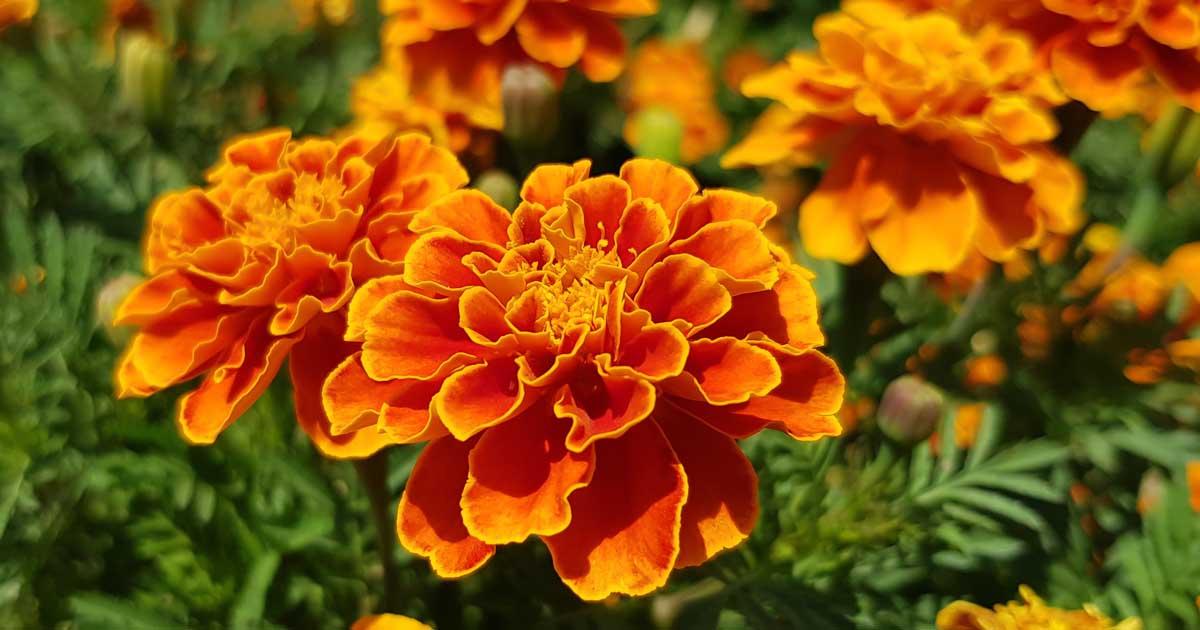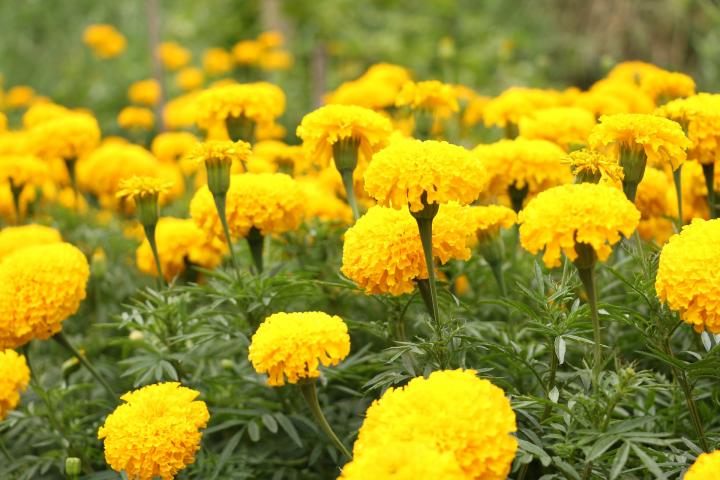The Golden Aura of Marigold: A Comprehensive Guide to Cultivation, Uses, and Folklore

The marigold, with its vibrant shades of yellow, orange, and red, is more than just a pretty face in the garden. This resilient and versatile flower boasts a rich history, diverse applications, and a captivating folklore that has woven its way through cultures around the world. From its ease of cultivation to its medicinal properties and culinary uses, the marigold offers a wealth of benefits that make it a valuable addition to any garden and a fascinating subject of study.
A Botanical Portrait: Understanding the Marigold Family
The term "marigold" encompasses several species, primarily belonging to the genera Calendula and Tagetes. While both are commonly referred to as marigolds, they possess distinct characteristics and are often used for different purposes.
Calendula (Pot Marigold): Calendula officinalis, often called pot marigold or English marigold, is prized for its medicinal properties. Its flowers are edible and used in teas, tinctures, and ointments. Calendula petals are known for their anti-inflammatory, antiseptic, and wound-healing properties. They typically have a milder scent compared to Tagetes.
Tagetes (French, African, and Signet Marigolds): The Tagetes genus includes various types, such as French marigolds (Tagetes patula), African marigolds (Tagetes erecta), and signet marigolds (Tagetes tenuifolia). These marigolds are primarily cultivated for their ornamental value and pest-repelling abilities. They are known for their strong, pungent scent, which helps deter nematodes and other garden pests.

Cultivating the Golden Bloom: A Gardener’s Guide
Marigolds are renowned for their ease of cultivation, making them a favorite among novice and experienced gardeners alike. Their adaptability to various soil types and climates contributes to their widespread popularity.

Planting: Marigolds can be started from seed indoors 6-8 weeks before the last frost or directly sown into the garden after the danger of frost has passed. Choose a sunny location with well-draining soil. Space plants according to their mature size, typically 8-12 inches apart for smaller varieties and 12-18 inches apart for larger ones.
Soil and Sunlight: Marigolds thrive in well-drained soil with a slightly acidic to neutral pH (6.0-7.0). They require at least six hours of direct sunlight per day to produce abundant blooms. While they can tolerate some shade, insufficient sunlight can lead to leggy growth and reduced flowering.
Watering: Water marigolds regularly, especially during dry spells. Avoid overwatering, as this can lead to root rot. Allow the soil to dry slightly between waterings.
Fertilizing: Marigolds are not heavy feeders and generally do not require excessive fertilization. A light application of a balanced fertilizer at planting time is usually sufficient. Avoid using fertilizers high in nitrogen, as this can promote leafy growth at the expense of flowering.
Deadheading: Deadheading, the removal of spent flowers, encourages continuous blooming throughout the growing season. Simply pinch or cut off the faded flowers just below the flower head.
Pest and Disease Control: Marigolds are relatively pest-resistant, but they can occasionally be affected by spider mites, aphids, and powdery mildew. Encourage beneficial insects like ladybugs and lacewings to control aphids and spider mites. Ensure good air circulation to prevent powdery mildew.

Beyond the Garden: The Multifaceted Uses of Marigold
The marigold’s appeal extends far beyond its ornamental value. Its diverse properties have led to its use in various fields, from medicine and cuisine to natural pest control and dye production.
Medicinal Applications: Calendula, in particular, has a long history of medicinal use. Its anti-inflammatory and antiseptic properties make it effective in treating skin irritations, wounds, burns, and eczema. Calendula-infused oils, creams, and salves are widely available for topical application. It is also sometimes used internally to aid digestion and boost the immune system, though consultation with a healthcare professional is always recommended.
Culinary Delights: Both Calendula and Tagetes petals are edible and can add a vibrant color and subtle flavor to salads, soups, and rice dishes. Calendula petals, with their milder flavor, are often used as a saffron substitute, adding a golden hue to dishes. Tagetes petals, particularly those of signet marigolds, have a citrusy flavor that complements savory dishes.
Natural Pest Control: The strong scent of Tagetes marigolds makes them an effective natural pest repellent. Planting them around vegetable gardens can help deter nematodes, aphids, whiteflies, and other harmful insects. The roots of Tagetes release a compound called alpha-terthienyl, which is toxic to nematodes.
Natural Dye: Marigold petals can be used to create natural dyes in shades of yellow, orange, and gold. The intensity of the color depends on the type of marigold, the mordant used (a substance that helps the dye bind to the fabric), and the dyeing process.
Companionship Planting: Marigolds are excellent companion plants for various vegetables and fruits. They are known to benefit tomatoes, peppers, eggplant, basil, and roses by repelling pests and attracting beneficial insects.
A Tapestry of Folklore: Marigold’s Cultural Significance
The marigold’s bright and cheerful appearance has made it a symbol of various virtues and emotions throughout history. Its cultural significance varies across different regions and traditions.
Symbolism: In some cultures, marigolds symbolize grief, sorrow, and remembrance, often used in Day of the Dead celebrations in Mexico. In other cultures, they represent joy, happiness, and good luck. Their association with the sun and gold has also linked them to wealth, prosperity, and creativity.
Religious Significance: In Hinduism, marigolds are considered sacred and are often used in religious ceremonies and offerings. They are associated with the goddess Lakshmi, the deity of wealth and prosperity.
Folklore and Superstition: In some European folklore, marigolds were believed to possess protective powers against evil spirits and were often planted near homes and doorways. They were also associated with love and marriage, and young women would sometimes use marigold petals in love potions or divination rituals.
Choosing the Right Marigold: A Variety for Every Garden
With numerous varieties of marigolds available, selecting the right one for your garden can seem daunting. Consider the following factors when making your choice:
Size: Marigolds range in size from dwarf varieties that reach only a few inches tall to larger varieties that can grow up to three feet tall. Choose a variety that suits the size of your garden and the space you have available.
Flower Type: Marigolds come in various flower types, including single, double, and crested. Single-flowered marigolds have a single row of petals, while double-flowered marigolds have multiple rows of petals. Crested marigolds have a raised, rounded center surrounded by petals.
Color: Marigolds are available in a wide range of colors, including yellow, orange, red, and bi-colored varieties. Choose colors that complement your garden’s overall aesthetic.
Purpose: Consider the intended use of the marigolds. If you plan to use them for medicinal purposes, choose Calendula. If you want to use them as pest repellents, choose Tagetes.
FAQ: Common Questions About Marigolds
Are marigolds annuals or perennials? Marigolds are generally considered annuals, meaning they complete their life cycle in one growing season.
How do I collect marigold seeds? Allow the flower heads to dry completely on the plant. Once dry, gently remove the petals and collect the seeds from the center of the flower head. Store the seeds in a cool, dry place until planting time.
Can I eat all types of marigolds? While both Calendula and Tagetes petals are edible, Calendula is generally preferred for culinary use due to its milder flavor.
Why are my marigolds not blooming? Insufficient sunlight, overwatering, or excessive fertilization can inhibit flowering. Ensure your marigolds receive at least six hours of direct sunlight per day, water them regularly but avoid overwatering, and avoid using fertilizers high in nitrogen.
Are marigolds toxic to pets? Marigolds are generally considered non-toxic to pets, but ingesting large quantities can cause mild digestive upset.
Conclusion: The Enduring Appeal of the Golden Flower
The marigold, with its vibrant colors, ease of cultivation, and diverse applications, remains a beloved flower for gardeners, herbalists, and enthusiasts alike. Its medicinal properties, culinary uses, and pest-repelling abilities make it a valuable addition to any garden and a fascinating subject of study. From its historical significance to its modern-day applications, the marigold continues to captivate and inspire, reminding us of the enduring beauty and power of the natural world. Whether you’re seeking a cheerful addition to your flowerbeds, a natural remedy for skin ailments, or a natural pest control solution, the marigold offers a golden opportunity to embrace the beauty and benefits of this remarkable flower. So, plant a few marigolds in your garden and experience the joy and wonder they bring to your life. You might just discover your new favorite flower.

